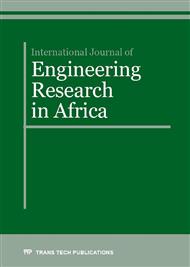[1]
Iran stone quarrying industry andGATT: Iran exports and imports. http: /www. rockstone. biz/iran-stone. php.
Google Scholar
[2]
Mosaferi, M. Dianat, I. Khatibi, M.S. Nemati Mansour, S. Fahiminia, M and Asl Hashem, A. Review of environmental aspects and waste management of stonecutting and fabrication industries. Journal of Material Cycles and waste Management. 16(4), (2013).
DOI: 10.1007/s10163-013-0193-y
Google Scholar
[3]
Mosaferi, M. Fahiminia, M. Taghipour, S. Environmental management of the solids wastes of stone cutting industries: a case study of Qom province. J Environ Sci Technol. 9(2), (2007), 65-73.
Google Scholar
[4]
Yarmohamadi Samani, H. Yarahmadi Bafghi, A.R. Prediction of the sawing quality of Marmarit stones using the capability of artificial neural network. International Journal for Numerical and Analytical Methods in Geomechanics. 36(7), (2012).
DOI: 10.1002/nag.1033
Google Scholar
[5]
Mbuligwe E. S, Kaseva, E.M. Assessment of industrial solid waste management and resource recovery practices in Tanzania. Resour Conserv Recy. 47, (2006), 260–276.
DOI: 10.1016/j.resconrec.2005.11.002
Google Scholar
[6]
Fahiminia, M. Ardani, R. Hashemi, S. Alizadeh, M. Wastewater Treatment of Stone Cutting Industries by Coagulation Process. Arch Hyg Sci. 2(1), (2013), 16-22.
Google Scholar
[7]
Bianchini, G. Marrocchino, E. Tassinari, R. and Vaccaro. Recycling ofconstruction and demolition waste materials: a chemical- mineralogical appraisal. Waste Management. 25(2), (2005), 149-159.
DOI: 10.1016/j.wasman.2004.09.005
Google Scholar
[8]
Alzboon, K. and Mahasneh, K.N. Effect of Using Stone Cutting Waste on the Compression Strength and Slump Characteristics of Concrete. World Academy of Science, Engineering and Technology. 3, (2009) 03-27.
Google Scholar
[9]
Pentecost, A. Travertine, Dordrecht, Netherlands: Kluwer Academic Publishers Group, (2005). ISBN 1-4020-3523-3.
Google Scholar
[10]
LEA,F.M. The chemistry of cement and concrete(London, Arnold, 1970).
Google Scholar
[11]
ACI COMMITTEE 211. 1-91.
Google Scholar
[12]
CONCRETE SOCIETY, Concrete core testing for strength, Technical Report. No. 11, p.44 (London, 1976).
Google Scholar
[13]
BS EN 14617-2: 2008, Agglomerated stone - Test methods - Part 2: Determination of flexural strength (bending).
DOI: 10.3403/03218452u
Google Scholar
[14]
EN 12372: 2007, Natural stone test methods - Determination of flexural strength under concentrated load.
DOI: 10.3403/30403938
Google Scholar
[15]
EN 14618: 2009, Agglomerated stone- Terminology and classification.
Google Scholar
[16]
EN 14617-16, Agglomerated stone - Test methods - Determination of dimensions, geometric characteristics and surface quality of modular tiles.
DOI: 10.3403/03248631u
Google Scholar
[17]
BS EN 14617-1: 2005, Agglomerated stone - Test methods - Part 1: Determination of Apparent Density and Water Absorption.
DOI: 10.3403/03245546
Google Scholar
[18]
BS EN 14617-4: 2012, Agglomerated stone - Test methods - Part 4: Determination of the abrasion resistance.
Google Scholar
[19]
ISO 8486-1: 1996, Bonded abrasives - Determination and designation of grain size distribution - Part 1: Macrogrits F4 to F220.
DOI: 10.3403/00949626u
Google Scholar
[20]
BS EN 16140: 2011, Natural stone test methods. Determination of sensitivity to changes in appearance produced by thermal cycles.
DOI: 10.3403/30228471u
Google Scholar


